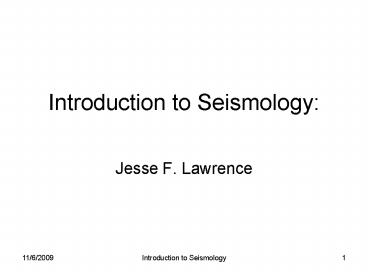Introduction to Seismology: PowerPoint PPT Presentation
1 / 47
Title: Introduction to Seismology:
1
Introduction to Seismology
- Jesse F. Lawrence
2
Earthquakes
- Earthquakes have long excited the minds of man.
3
(No Transcript)
4
(No Transcript)
5
Fundamental Idea of Seismology
- The Earth ruptures, releasing vibrational energy.
- Vibrational energy travels through the Earth.
- A seismometer records the vibrations some
distance away.
6
Ray Theory
- Seismic waves can be idealized as rays.
- They fan out in all directions from an earthquake.
7
Ray Theory Examples
- Seismic waves can be idealized as rays.
- The rays fan out in all directions from an
earthquake. - The rays can bounce off of objects in the Earth.
- The surface
- The core
8
Ray Theory Examples
- Sometimes the waves make multiple bounces up and
down through the Earth.
9
Ray Theory Examples
- Energy can also bounce off of smaller interfaces
- Like interfaces between sediment layers
- The crust-mantle boundary
10
Seismic Reflection Survey
- Man made sources and receivers can be placed at
regular distances. - Energy bounces off of interfaces at shallow
depths.
11
First Motion Fault Orientation
- Energy leaving an Earthquake can have positive or
negative amplitude - Motion toward (positive) or away (negative) from
the receiver. - We can back out the direction of motion of the
fault.
12
Inversion
- Based on the data, we develop a model of the
Earth. - Calculate synthetic data based on the input
model - Reduce misfit with the real data.
13
Data v. Uncertainty
- As the amount of data goes up, the uncertainty
goes down
14
Fault Planes Plate Boundaries
15
Fault Planes Plate Boundaries
16
Fault Planes Plate Boundaries
17
Earthquake Frequency v. Magnitude
18
Earthquake Frequency v. Magnitude
- There are fewer large Earthquakes than small, but
the large earthquakes release more energy than
the small earthquakes.
19
Notable Earthquakes
20
Earthquakes Need not be Disastrous
- In 1996 it was determined that on average in the
US more people died of skateboarding than
Earthquakes - Building codes
- Earthquake preparedness
- Search rescue
21
Likelihood of Building Collapse EQ Intensity
22
(No Transcript)
23
Most Active Region in the US
24
San Andreas Fault
25
Seismic Hazard
- Seismic hazard is effected by
- Closeness to Earthquake
- Likelihood of Flood
- Likelihood of Landslide
- Likelihood of Tsunami
- Ground Stability
26
Seismic Energy and Distance
27
Seismic Hazard
28
Seismic Hazard
29
Seismic Gaps
30
Vibrational Energy Attenuates
31
Damage in Valdez after 1964 Alaska EQ
32
Displacement after 1906 San Andreas
33
(No Transcript)
34
Loma Prieta, 1989 Liquefaction Effects
35
Bay Bridge after Loma Prieta, 1989
36
Van Norman Dam after 1971 San Fernando EQ
- Liquefaction made the dam sink
37
Bridge After Northridge
38
Bridge After Northridge
39
Liquefaction During Northridge
40
Tsunami, 1964, Alaska
41
Landslide From Loma Prieta, 1989
42
Animals Earthquakes?
- Elephants communicate over kilometers at
frequencies similar to earthquakes. - Some animals may sense the first-arriving P-wave
and act up. - Humans only notice the later arriving surface
waves that knock over buildings.
43
Nuclear Sources
Lots of Energy coupled to the ground!!!!
44
Nuclear Sources
45
Sizes of Nuclear Tests
46
Earthquakes v. Nuclear Sources
- Nuclear sources tend to have only higher
frequencies
47
Earthquakes v. Nuclear Sources
- Nuclear explosions have less long-period energy,
so estimations of source size based on surface
waves is much lower.

